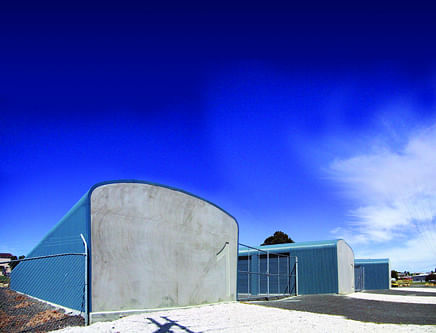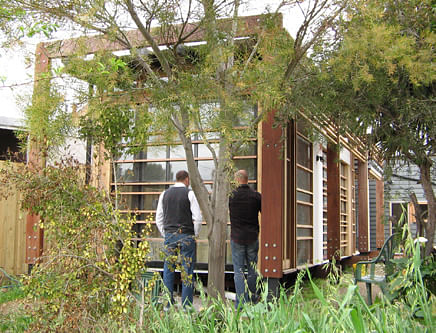

The one thing you will not find in school--or even on Architecture Registration Exams--is a course on how to get work, yet it is one of the most basic needs of any design practice. In fact, if you don't have an equal ability to experiment in getting work as you do in doing work you would be fortunate to make it past the first five years.
UpStarts is a series of features on the foundations of contemporary practice. It will have a global reach in which practices from Europe, North America, Asia, and beyond will be asked to address the work behind getting the work, and the effect of cultural contexts. The focus will be on how a practice is initiated and maintained. In many ways, the critical years of a fledgling design partnership is within the initial five years, after the haze and daze of getting it off the ground. UpStarts will survey the first years of practice as a tool for tracking the tactics of the rapidly evolving methods for sustaining a practice.
The first series is a dialogue with Studio Sputnik in Rotterdam, 51N4E in Brussels, and Andrew Maynard in Melbourne. Mason White's dialogue took place with Andrew Maynard by email in September 2005. Maynard officially started up his practice in 2002.
1. My first question is pretty simple. I am wondering how you initiated your practice? How did you know it was the right time in your career to start a private practice?
The right time ? Two reasons: (1.) I HATE working for other people; (2.) I get very worried that I will only be around for approximately 80 years before I drop dead. In the grand scheme of things this is a very short amount of time to spend creating and exploring.
I started my practice when I was 27 and the decision was an easy one. I simply needed a couple of jobs to get me underway. When I returned to Melbourne from a short time at Richard Rogers Partnership in London I began to assemble my folio so that I could find employment. Luckily, while I was in London, some family and friends had been lying to several people about how wonderful I was. From these referrals I landed the Sproule house and Kings Meadows Self Storage (KMSS) on the same day and my practice was underway.
There was no fear in making the decision to start a practice. The main thing that stops people from doing what there want is fear of instability and failure (usually financial). I knew that I could live on a very small income and I knew that patience was all I required before a steady stream of work came in the door. Starting a practice requires a lot of patience.
Kings Meadows Self Storage, Tasmania, Australia (2003), private commission.
Sproule Residence, Carlton, Australia (2004), private commission.
2. It seems as if the right timing was more an opportunity that presented itself as a chance to go solo and you, rightfully, pounced on it. So if the first two projects landed in your lap through word of mouth at age 27, how do you maintain that momentum today?
Ah, well thats the tricky part and I'm sure its the issue that makes most people give up. There is a natural loss of momentum once your first projects enter the construction stage. Your fees slow and there is nothing in the pipe line.
I had decided at the outset that income and fees would not dictate the course of my practice. From the start I had a number of design competitions underway. Though it would be great to win work this way I was very pessimistic of this happening. Instead, I used competitions to explore a number of issues that I want to explore without the confines of client and budget. These projects were the work that I was far more interested in promoting and marketing as they represented the type of work that I wanted to be doing. The media also found many of these projects interesting and this helped generate more work.
3. Do you continue to await projects to fortuitously appear or are you actively seeking them, and how?
When I needed to feed the family I would do letter drops around areas where I knew the population generally shared the same ideology as me. This method would easily drum up one or two small residential projects. Another method of gaining work [and momentum] was to approach established smaller firms and establish a friendly relationship. These firms inevitably started sending work my way when they were to busy or the work was considered too small.
During this period I always had my eye on marketing everything and anything that we were involved in. It is amazing how interested people are in architecture. I simply kept no secrets. I told media, press, clients -- past, present and potential -- friends, family etc everything that we were doing. People became very interested in our journey and have followed us on our way.
Today we seem to be reaping the rewards of our efforts. We now have momentum. Marketing is less necessary as our past built work, awards, ongoing projects and the network of people that talk about us is big enough to bring in constant work. Today we turn away around 20% of the projects that come in the door as we are busy enough to pick and choose the good projects and more importantly the great clients.
Styx Valley Protest Shelter, Tasmania, Australia (2003), unbuilt proposal.
Kaur House, Australia (2005-), private commission.
4. Whoa, letter drops? Do you mean literally dropping your portfolio in mailboxes of strangers writing �let me know if you need an architect�? Can you speak a little more specifically about some of these proactive methods of getting jobs?
We dropped a "hello" card in letterboxes, with a business card attached, in areas where we knew people shared a similar ideology to ourselves. We identified a market and carpet-bombed them. These cards simply acted as an introduction when we moved offices to a new area. They generated much interest and some work when we put them out. We did a print run of 2500. We decided not to go for the hard sell. We didn't want to say "give us a job" rather we made it more informal.
We always say YES. There are so many opportunities around and it is very easy to be too busy to take advantage. We decided from the outset to always say yes to invites such as being a guest speaker, being on a panel, being in a exhibition, entering competitions, donating time to charitable organizations. Now we are know as proactive, energetic and enthusiastic emerging architects and this image creates a lot of interest and work.
5. You have talked a lot about private work, which seemed to have helped get your firm started. Is more public work also a possibility for young or small practices in and around Melbourne? Does this differ in other metropolitan areas, such as Sydney or Brisbane?
Sadly Australia is a conservative country. Because of this it is difficult for young practices to get more public work. Of all the cities in Australia, Melbourne is probably the most generous to young practices, however public opportunities are quite limited. In general public work goes to established, often well connected, practices. Beachcroft Orth house (2005), private commission.
Beachcroft Orth house (2005), private commission. Beachcroft Orth house (2005), private commission.
Beachcroft Orth house (2005), private commission.
6. About how much of a role would you say marketing plays in the early years of a practice? What outlets are best to use for reaching the public?
Marketing is essential. Market your arses off kids! Marketing is fundamental because it is your only opportunity to say to the world "this is what we do and what we want to do in the future." If you don't loudly dictate the path that you wish to take from the outset then clients or other external factors will generate your trajectory. Once your practice has an image and a direction it is very hard to steer it in any other direction. I'd say that we aimed at 80% marketing/positioning and 20% fee paid work in the first 3 years. We are now 3.5 years old and have only just begun focusing more on paid work. Our patience in the first few years has given us a trajectory that we really like.
Creative Commons License
UpStarts is licensed under a Creative Commons Attribution-NoDerivs 2.5 License .
/Creative Commons License
1 Comment
I've come to Architecture after a degree and successful career in the business world and found my first 5 years relatively frustrating. In school and directly after, most architects seemed to feel that being successful was merely talent and had nothing to do with business. I even had a partener in a firm tell me marketing was worthless! Now I'm out on my own and finding that, just as I thought, the business background is a true blessing. I appreciate the importance of marketing, being part of the community and building relationships. Until we, as architects, shed our elitist desires and help others understand the value we add, we can't ask for compensation in the form of either money or respect.
Thanks for the soap box, and the story.
Block this user
Are you sure you want to block this user and hide all related comments throughout the site?
Archinect
This is your first comment on Archinect. Your comment will be visible once approved.